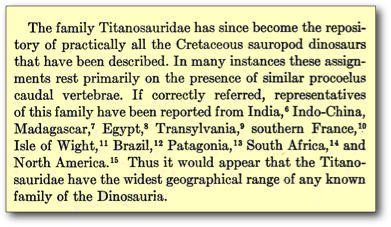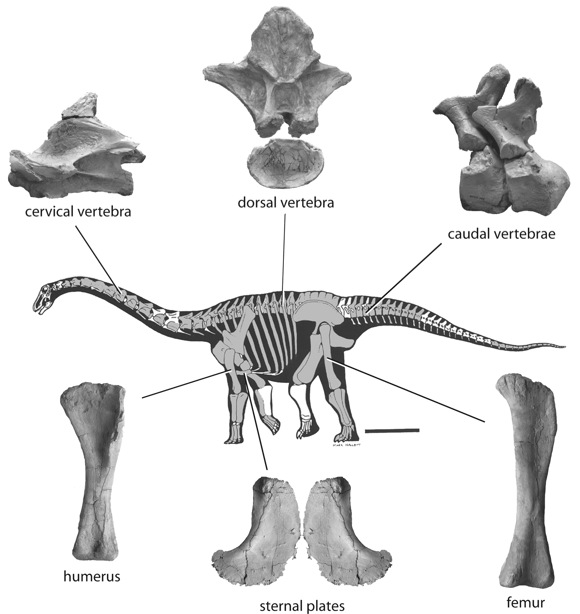
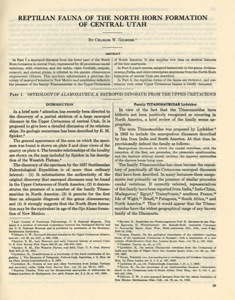
Introduction to Titanosauria

Early Discoveries
Bones of Titanosaurus were first discovered in the central provinces of India in 1828 by Sir William Henry Sleeman (below), assistant to the Governor-General's agent in the Saugor and Nerbudda territories. Sleeman was probably best known from bringing down the cult of the Thuggee, who were notorious for strangling and robbing travelers in central India, as depicted above (’thuggee’ is the source of the English word ‘thug’). Sleeman created a genealogy of the Thuggee that he used to systematically target smaller subgroups and eventually dismantle the entire group. While stationed at Jubbulpore (now Jabalpur), Sleeman collected fossil dinosaur bones from nearby Bara Simla Hill. Sleeman’s account of his discovery, from “Rambles and Recollections of an Indian official,” can be found here (p. 127, ¶ 1). Sleeman’s specimens were passed to a Mr. Spilsbury, who sent them to the Indian Museum in Calcutta in 1832. By 1862 they were with Hugh Falconer (below), who was then Superintendent of the nascent Geological Survey of India. Falconer recognised the reptilian character of the vertebrae and provided a description and principal measurements for both, as well as illustrations of the better preserved of them. He did not, however, name the bones.
Lydekker (1893:3) and Depéret (1899) described species of Titanosaurus from South America and Madagascar, recognizing a “remarkable community of type which undoubtedly exists between the faunas of southern continents of the world”. Titanosaurus and the Family Titanosauridae (Lydekker, 1893) soon swelled to include numerous constituent taxa, despite often tenuous associations and limited morphological overlap. Fifty years later, Charles Gilmore (1946) recognized that the family represented a wastebasket taxon (see below). “Titanosaurus indicus”, “Titanosauridae” and coordinated rank-taxa are now considered invalid (Wilson & Upchurch 2003), but the unranked taxon Titanosauria remains valid.
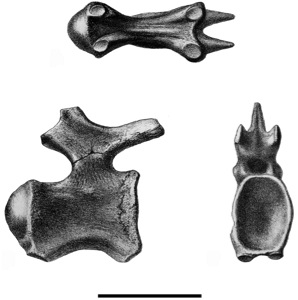
Colored drawing of Thuggees attacking a traveller on horseback, by a native Indian artist. From the British Library. The fortified hill in the central background may represent Bara Simla, the site of discovery of Titanosaurus indicus.
These two vertebrae, together with a fragmentary femur collected from the same locality in 1871 by the geologist Henry Medlicott, formed the basis of the new taxon Titanosaurus indicus by Richard Lydekker in 1877 (above). Because Lydekker (1877:38) did not specify one of these elements as the holotype (‘type’ in former parlance), the three elements together form the type series. In his description of the new species, Lydekker (1877:40) recognized the animal as a dinosaur and noted several diagnostic features of the vertebrae but failed to identify distinctive features in the femur, remarking “if the femur had been found alone, I should have referred it to the [British] genus Cetiosaurus, but the vertebrae forbid this view”. Matley (1921) later demonstrated the femur came from the ‘Green sand’ below the ‘Main Lameta Limestone’ that produced the vertebrae; Huene & Matley (1933:29) formally excluded the femur from the type series of T. indicus.


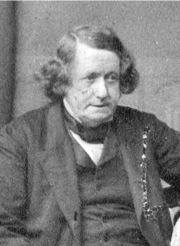
British men who discovered, described, and named Titanosaurus indicus in the 1800s. From L-R, Sir. W. H. Sleeman (photo from J. Sleeman 1933), Hugh Falconer (photo from his 1868 memoirs), and Richard Lydekker (photo from The Natural History Museum).
The holotypic caudal vertebrae can no longer be located at the British Museum of Natural History or the Geological Survey of India; as a consequence, the morphology of these bones is only available from published illustrations (photographs are as yet unknown). Falconer’s illustration of the bones (at right) indicates that the caudal vertebra has ball-and-socket articulations ‘procoelous’, a condition that was not present in other dinosaurs at the time of discovery. Like other early dinosaur discoveries (e.g., Iguanodon anglicus, Megalosaurus bucklandii, Cetiosaurus medius), T. indicus was founded on fragmentary remains with few diagnostic characters. Over time, many new and often fragmentary specimens were referred to the genus or named as closely related genera, based on the presence of procoelous caudal vertebrae.
Holotypic caudal vertebra of Titanosaurus indicus in bottom, side, and front views (from Falconer 1868).
Previous examinations of titanosaurian systematics
Initial work by Lydekker (1877, 1893), Marsh (1895), and Huene (1929, 1932) established Titanosauridae as a unique sauropod subgroup diagnosed on the basis of procoelous caudal vertebrae (see image below right). In the first higher-level classification of Sauropoda, Janensch (1929) grouped together Titanosauridae with Diplodocidae on the basis of narrow tooth crowns and elevated external nares, as suggested by Huene’s (1929) reconstruction of Antarctosaurus (see image below). This classification was widely accepted and became the paradigm for sauropod taxonomy (Lapparent and Lavocat, 1955; Romer, 1966; Steel, 1970; Carroll, 1988).
Few fossil discoveries or taxonomic revisions of “Titanosaurus”-like animals occurred until the 1970s, when field exploration in southern South America yielded several new and well-preserved specimens (reviewed in Bonaparte, 1996). This field work led to the first taxonomy for South American Titanosauridae, which established the Late Cretaceous Subfamilies Titanosaurinae, Saltasaurinae, Argyrosaurinae, and Antarctosaurinae but provided no hierarchical structure within the group (Powell, 1986, 2003). Subsequent discovery of Early Cretaceous sauropods that resembled typical titanosaurs but lacked procoelous caudal centra and other titanosaurid features (e.g., Andesaurus; Calvo and Bonaparte, 1991) led Bonaparte and Coria (1993) to create the new higher taxon Titanosauria, which they divided into the earlier-appearing, primitive Andesauridae and the later-appearing, more derived Titanosauridae. Although Andesauridae is now acknowledged to be a paraphyletic assemblage linked by plesiomorphic features (i.e., Salgado et al., 1997), and Titanosauridae is likewise recognized to be invalid (Wilson and Upchurch, 2003), the basic recognition of a derived subgroup of titanosaurs is agreed upon by recent cladistic analyses, as discussed below.
The first cladistic analyses of Sauropoda addressed higher-level relationships of the group, with little investigation of its subgroups (Calvo and Salgado, 1995; Upchurch, 1995; Salgado et al., 1997; Wilson and Sereno, 1998). Although the analysis of Upchurch (1995) supported the traditional dichotomy of sauropods into broad- and narrow-crowned clades first suggested by Janensch (1929), the analyses of Salgado et al. (1997) and Wilson and Sereno (1998) provided evidence that titanosaurs share closest ancestry with Brachiosaurus-like taxa. This result has been corroborated in subsequent cladistic analyses focusing on lower-level relationships of Sauropoda (Upchurch, 1998; Wilson, 2002). These latter analyses and several others (Salgado et al., 1997; Sanz et al., 1999; Curry Rogers and Forster, 2001; Calvo and González Riga, 2003; González Riga, 2003; Upchurch et al., 2004; Curry Rogers, 2005) evaluated the evolutionary history of titanosaurs. Please go to CHARACTERS to see earlier character lists and matrices, as well as our list of core titanosaur characters.
Our proposed new analysis of titanosaur relationships is timely because it follows closely on the recent description of several key specimens. These include (1) the first titanosaur with associated cranial and postcranial remains (Rapetosaurus; Curry Rogers and Forster, 2001, 2004), (2) first embryonic titanosaur remains (Chiappe et al., 1998, 2001; Salgado et al., 2005), and (3) nearly complete associated or articulated postcranial skeletons from South America (Mendozasaurus González Riga, 2003; Epachthosaurus Martínez et al., 2004; Gondwanatitan Kellner and Azevedo, 1999; Bonatitan Martinelli and Farasiepi, 2004), Asia (Phuwiangosaurus Martin et al., 1994; Tangvayosaurus Allain et al., 1999), India (Isisaurus Jain and Bandyopadhyay 1997), Europe (Lirainosaurus Sanz et al., 1999; Ampelosaurus Le Loeuff, 1995; 2003), and Africa (Malawisaurus Jacobs et al., 1993; Gomani, 2005; Paralatitan Smith et al., 2001). Most of these important specimens have not yet been incorporated into cladistic analysis and will provide important character combinations for resolving titanosaur phylogeny.
Reconstructed skeleton of the Malagasy titanosaur Rapetosaurus krausei, the first titanosaur known from associated cranial and postcranial remains (modified from Curry Rogers & Forster 2001).

Excerpt from Charles Gilmore’s 1946 monograph on Alamosaurus, North America’s first titanosaur (p. 29).
